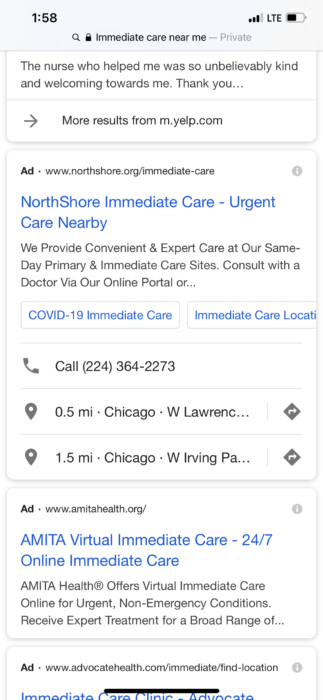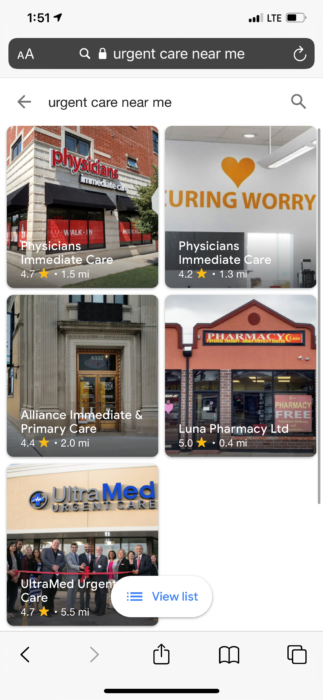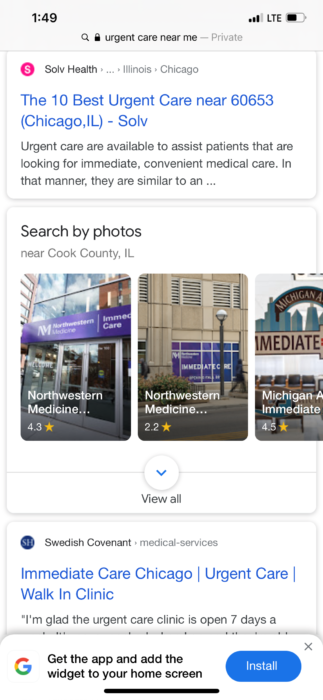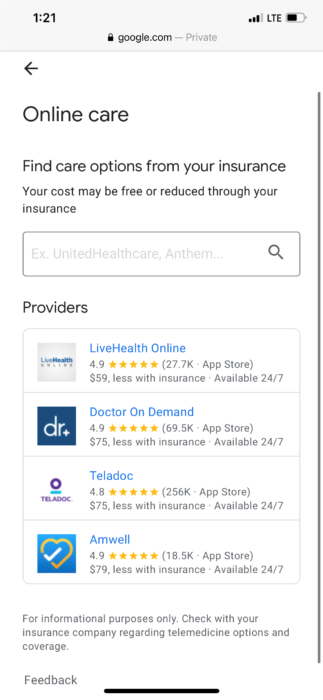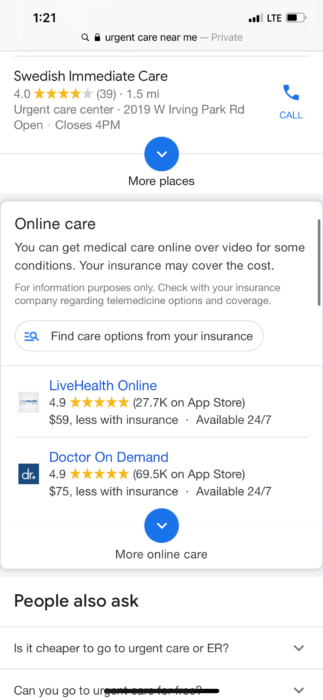1. Your site has a technical issue preventing the page from ranking
I’m surprised how often I review a hospital’s site only to uncover technical issues that are preventing search engines from indexing the pages.
The most typical issue I run across is the “meta noindex tag.” This is a line of code that tells search engines not to index the page in search. In other words, the page will not appear when you search for it in Google. This line of code is often triggered by a checkbox or similar feature within the content editor of your content management system (CMS), which is why problems arise when you have many editors or unfamiliar users updating your website.
The meta noindex tag looks like this:
<meta name=”robots” content=”noindex”>
If you’re curious whether a page has this tag, view the page’s source code and search for “noindex.” Another place the “noindex” directive might appear is within the HTTP response header.
Note that there are occasions where using a “noindex” tag to hide a page from search makes sense. For example, a campaign landing page that you only want to direct paid traffic to, or utility pages such as a form submission confirmation page.
While checking the source code of a page may work in one-off situations, it’s better to use a tool like Moz, SiteImprove, or Screaming Frog to perform a crawl of your site. This will give you a nicely-structured report of all pages that contain ‘noindex,’ as well as other issues that affect SEO.
If you do find a page with a “noindex” tag that you want to be indexed, remove the tag (or ask your web vendor how), and request Google to index the page within Google Search Console. Then, have a conversation with your team or establish an SEO governance plan to prevent these issues from arising in the future.
2. Your page topic doesn’t align with your targeted keyword
The second reason a page may not rank for a keyword is that your content isn’t effectively targeting your chosen keyword. In other words, Google doesn’t see your page as a good answer to the question users are searching for. Google always strives to serve the most relevant content to a user. So if you have a page called “Classes” and you’re trying to rank for a search for “birthing classes,” your page topic isn’t specific enough.
Ideally, the topic of your page and your chosen keyword should be identical or closely align. How does Google know the topic of your page? The text appearing in your page’s URL, HTML page title, and H1 are the first places Google looks to understand your page topic. That’s why you have to make careful decisions about what keywords you place in those critical areas.
The other reason your page may not be relevant enough is you’re trying to target too many keywords with one page. Are you trying to rank for “birthing classes,” “prenatal yoga,” and “birth center tours,” with a single page? If it’s important for your organization to rank well for each of these searches, these topics should be broken out into separate pages – each with their own URL, HTML page title, and H1 where you can place these valuable keywords.
When deciding whether to target multiple keywords with a page, think about the user’s intent and what they would expect to find. A user searching for “prenatal yoga” wants very different information than someone searching for “birthing classes.” But a user searching for “bariatric surgery” wants the same information as someone searching for “weight loss surgery,” so these keywords can be targeted by the same page. This mental exercise will help you to ensure that you’re building pages with the most relevant information for your search query and providing a good experience for your users. Now you’re thinking like Google!
3. Your content isn’t geographically relevant to a local user
Remember how I said Google wants to serve the most relevant information to a user? That includes their geographic location. For many healthcare searches, Google makes it a priority to serve people local results for services near them.
Searches like “cardiologist,” “urgent care,” “pain clinic,” or “orthopedics” all prioritize websites from local organizations. That’s why it’s important that your website makes it clear which cities you serve. If your website isn’t ranking for a local keyword, it’s possible that Google doesn’t have a clear understanding of the local areas you serve.
Naturally incorporating city keywords within your page titles, headings, and body copy will help Google to better understand those regions you serve. This can be difficult if you’re a large organization spread across many cities, so strategically optimizing your service line content and building robust location pages to rank for these searches can often help you to remain competitive.
4. Your page has little or no authority
While relevance is an important factor for SEO, so is authority. Google wants to give users relevant and reliable information. This is especially important for healthcare.
Linking
The primary way your page gains authority is through links. The more links you have from quality, authoritative sites, the more Google will see your site as a reliable source of information. The more that you can do to build links to your site, whether through content marketing or outreach, the more weight your domain will carry in the search engine results pages (SERPs).
However, having a good internal cross-linking strategy within your site is just as important. It may be hard for deeper pages to gain authority if there are little or no external links to them. Internal links can pass authority from high-authority pages like your homepage or service line landing pages down to deeper sub-pages on your site. If a page isn’t ranking well in search, placing strategic internal links to your page can help improve the page’s authority quickly.
301 Redirects
One of the biggest issues I come across related to authority is the improper use (or lack of) redirects. If you change a page’s URL but don’t implement a 301 redirect from the old page to the new one, you’ve just destroyed your page’s authority. Google won’t correlate your old page with your new page, so you’re essentially starting over from scratch. By implementing a 301 redirect, you pass most of the previous page’s authority to your new page, thus preserving its hard-earned SEO. This is especially critical when you are going through a redesign and changing your site’s structure or domain.
Canonical URLs
Another issue that often hurts a page’s authority is duplicate content. If you have a page that is identical or nearly identical to another page, Google may choose not to rank it in search. This often happens with provider profiles that display across multiple domains.
If you have a preference as to which URL you want to rank, you can indicate this to Google with the rel=canonical element, which looks something like this:
<link rel=”canonical” href=”http://yoursite.com/your-preferred-URL” />
Placing this element on each of your duplicate pages with the preferred URL you want to rank will tell Google which URL you want to display in search results. Note that this will also prevent the other URLs from appearing in search.
5. The keyword you’re targeting is too difficult
SEO for healthcare is unique because the tactics necessary to rank for a keyword vary drastically. For searches for healthcare services, Google highly prioritizes relevance over authority, preferring to rank local websites. For searches related to healthcare conditions or treatments, Google highly prioritizes authority, preferring to rank nationally-recognized brands that have a long-standing reputation.
If the keyword you’re targeting falls into this second realm, you may be barking up the wrong proverbial tree, and your efforts may be better spent targeting another keyword.
When deciding whether to go after a keyword, consider the value gained by ranking for the keyword versus the amount of effort required. Is the time spent optimizing your site to rank going to pay off in the long run?
Estimating Keyword Value
When estimating a keyword’s value, think about the user’s intent and your marketing funnel. Searches for conditions like “heart disease” or “flu symptoms” tend to be informative searches falling at the top of the marketing funnel. These searches may not offer your organization as much return on investment as a search at the bottom of the funnel, such as “cardiologist” or “urgent care near me.”
One of the best ways to estimate a keyword’s value is by running a paid search campaign with your prospective keywords to identify those that are the highest converting. This allows you to go beyond search volume and understand which keywords will actually drive revenue.
Estimating Keyword Effort
When estimating the effort required to rank for a keyword, evaluate the sites currently ranking. Are they local sites, or is Google prioritizing high-authority sites with many inbound links? How are they targeting those keywords with their content? How many inbound links do they have?
Searches for “heart disease” return sites like Mayo Clinic, the CDC, and WebMD.
The Mayo Clinic has over 11.1 million inbound links to their domain. Even if this keyword has some value to your organization, the effort required to rank for this keyword is extremely high. You may be better off researching related, niche keywords that your local users search for, such as “heart disease treatment albuquerque nm.”
Get started and get ranking
While SEO can be complicated, it doesn’t have to be. If you follow the five guidelines above, your site should be in a good position to be competitive in search.
If you’re still having issues, or want help fixing the problems you uncover, Geonetric’s digital marketing team can perform an SEO assessment or jump in and start fixing the issues. Drop us a line and let’s get back those rankings you’ve worked so hard for!
And if you want to learn more, be sure to check our Ask the Experts: Get Answers to Your Top Healthcare SEO Questions webinar.


